Seafood and the Environment
Enjoy the seafood you love today, tomorrow and always!
If the saying “You are what you eat” is true, then eating sustainable seafood means you care about your health, the health of the planet, and enjoying truly good food.
How to Buy Sustainable Seafood
 Trust Your Retailers
Trust Your Retailers
Making sustainable choices is easier than it has ever been. About 90% of U.S. retailers have seafood sustainability purchasing programs in place, and they have these posted on their website.
 Ask Questions
Ask Questions
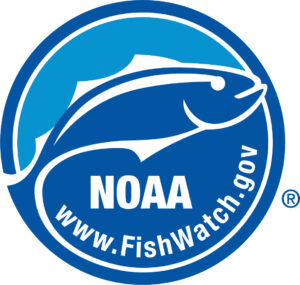 Asking questions about how your seafood was harvested and where it came from can help you determine if it’s good for the planet. In the absence of a certification, you can use this information to reference digital guides such as NOAA Fisheries‘ FishWatch for a listing of best choices.
Asking questions about how your seafood was harvested and where it came from can help you determine if it’s good for the planet. In the absence of a certification, you can use this information to reference digital guides such as NOAA Fisheries‘ FishWatch for a listing of best choices.
Remember, it’s not wild versus farmed, it’s responsible versus not. Sustainable seafood means that wild caught seafood comes from a well-managed fishery and farmed seafood comes from a farm following responsible practices.
What to ask at the seafood counter
- Where is the seafood from?
- Is there a 3rd-party certification?
- How long has it been on display? Or, when did you get this in?
 Look for certified
Look for certified
There are several sustainable seafood certifications and oversight programs that work with fisheries, farms and companies to ensure a safe, healthy and accountable seafood supply. For logos on seafood products, look for Aquaculture Stewardship Council (ASC) and Best Aquaculture Practices (BAP) for farmed fish; Marine Stewardship Council (MSC) and Alaska Responsible Fisheries Management (RFM) for wild-caught fish; Fair Trade USA; and any seafood certification programs benchmarked against GSSI.
 When in doubt, buy U.S.
When in doubt, buy U.S.
The United States is a global leader in responsibly managed fisheries and sustainable seafood.
FAQs
The Seafood Nutrition Partnership is committed to the waters that provide the seafood we eat and our work is mindful of how to ensure seafood is available for future generations to come. For us, eating seafood and the health of the environment are inextricably linked. Seafood is a vital part of the human diet that supports both human health and environmental health. The traditional Western diet is crushing much of the world with a chronic disease crisis that can only be overturned with adoption of a healthier dietary pattern that is rich in plants and lean protein such as seafood.1 Adopting a healthier dietary pattern, however, must coincide with the ability for those foods to be produced with lower impact to the environment to stand a better chance of ensuring our future food security.2 Essentially, the outlook for human health and environmental health depend in large part with what we put on our plates each day.
To have a sustainable supply of seafood for future generations means that seafood needs to be caught or farmed in environmentally and socially responsible methods. While our mission is focused on promoting a healthier population through seafood nutrition, we are grateful for the work conducted by organizations that support sustainable and responsible seafood with frameworks for those in the seafood sector to be able to bring healthy seafood to the consumer. See below for a list of these organizations.
SOURCES
- Fung, TT, Rimm EB; Spiegelman D, Rifai N, Tofler GH, Willett WC, Hu FB. Association between dietary patterns and plasma biomarkers of obesity and cardiovascular disease risk. The American Journal of Clinical Nutrition 73 (1): 61–7. PMID 11124751.
- Rockström J, Stordalen GA, Horton R. Acting in the Anthropocene: the EAT–Lancet Commission. The Lancet. 387 (10036): 2364-5. June 11, 2016.
Certification provides a level of assurance that the product is sustainable/responsible, is harvested legally, and is traceable back to its source. Certifications directly engage with fisheries or farms and require them to address social and environmental challenges to improve and meet the certification standard. Certifications also engage with the supply chain to verify the sustainability/responsibility and origin of certified products.
Global demand for seafood has outgrown the production of sustainable wild-caught seafood that our oceans can support. Fish is a high-protein, low-fat, healthy and nutritionally rich food. Aquaculture has the capacity to help meet global demand while reducing the pressure on wild fisheries. Aquaculture is the fastest growing food production system in the world, and more than half of the fish consumed globally comes from aquaculture. By choosing sustainable wild-caught and responsibly farmed seafood, you can feel confident that either is a healthy choice for you and for the ocean.
Here’s a snapshot of global seafood production from the UN. Two things stand out—wild catch has been flat for nearly 20 years, and fish farming (aquaculture) continues to grow at an impressive rate. These trends are expected to continue for the next 10 to 15 years.
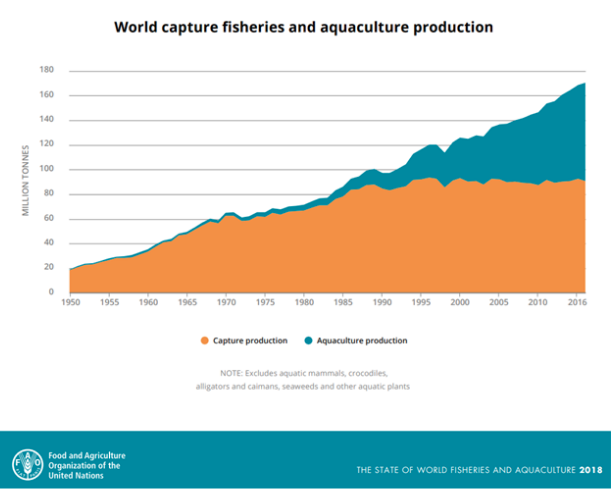
Fish and shellfish are renewable resources—they can reproduce and replenish their populations naturally. Because of this, we can sustainably harvest fish within certain limits without depleting the resource, given proper management. Fishery managers, such as the National Oceanic and Atmospheric Administration (NOAA Fisheries) here in the United States, use science to determine these limits, ensuring that the right amount of fish are caught while enough are left in the ocean to reproduce and replace the fish that were harvested. One of the requirements for all fisheries in the MSC program is to ensure that fish populations are healthy and thriving and can reproduce indefinitely. With good management systems, we can supply seafood for generations to come.
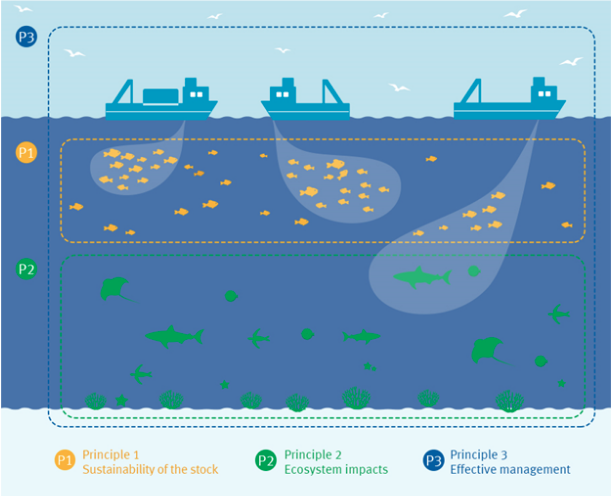
This graphic from the MSC is a good representation of the main factors that contribute to maintaining a sustainable wild fishery:
- The health of the fish and fisheries we’re trying to catch (orange)
- The impact that fishing has on the ecosystem or other species (green)
- How the fishing is managed (blue)
What to buy: Look for a trusted certification such as Marine Stewardship Council or Alaska Responsible Fisheries Management (RFM) to ensure best practices are in place ensuring we have wild seafood for the future. And, choose underutilized species that are U.S.-caught and/or eat lower on the food chain (smaller fish).
Well-managed fish farming can help meet the growing demand for seafood while minimizing environmental and social impacts. Aquaculture can feed more people using less land, energy and freshwater than terrestrial farming. Fish farming emits less carbon dioxide than livestock production. However, poor farming practices can contribute to habitat degradation and pollution.
Like wild fisheries, the ‘where’ and ‘how’ are generally how we assess the environmental impacts of fish farming:
- Is it an open or a closed system (i.e. can fish or waste get out)? Is it in the ocean or on land?
- Do you need to feed them? If so, with what?
- What is the density of the animals? What happens if/when they get sick?
- What techniques are used to harvest the fish when they’re ready?
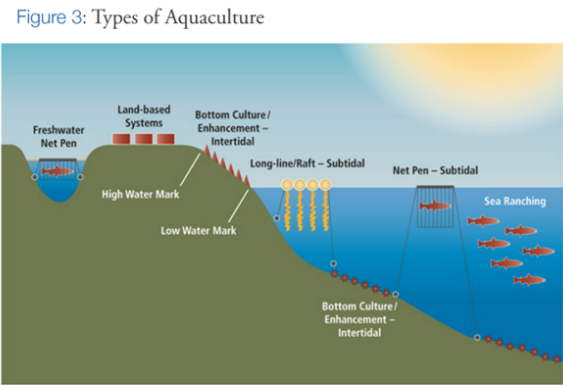
Aquaculture certification programs such as the Aquaculture Stewardship Council (ASC) and Best Aquaculture Practices (BAP) require farms to demonstrate best-practice performance, including clear requirements to minimize environmental and social impacts:
- legal compliance (obeying the law, the legal right to be there)
- preservation of the natural environment and biodiversity
- preservation of water resources and water quality
- preservation of diversity of species and wild populations (e.g. preventing escapes which could pose a threat to wild fish)
- responsible use and sourcing of animal feed and other resources
- good animal health and husbandry (no unnecessary use of antibiotics and chemicals)
- social responsibility (e.g. no child labor, health and safety of workers, freedom of assembly, community relations)
What to buy: Fish from farms that are Aquaculture Stewardship Council (ASC) or Best Aquaculture Practices (BAP) certified. Look for “Best Choice” rated species on Seafood Watch.
The United States is a global leader in responsibly managed fisheries. U.S. fisheries are managed by the National Oceanic and Atmospheric Administration (NOAA Fisheries), as mandated by the Magnuson Stevens Act. In addition, the State of Alaska has mandated sustainable seafood in its constitution.
Almost all fishing methods can be sustainable (with a few notable exceptions, such as cyanide or explosive fishing, which are always detrimental), and each method comes with its own set of pro’s and con’s. Some reduce the chance of catching unintended species (bycatch), while others have a lower carbon footprint. If a product is certified, that seafood has been harvested with minimal impacts to the environment.
Omega-3 fatty acid levels in seafood are largely dependent on what that fish has consumed throughout its lifetime. Because of this, omega-3 levels vary based on many factors, including by species, where it lived, and even time of year it was caught. For farmed fish, the omega-3 content is impacted largely by the feed, and many aquaculture farmers try to match or even exceed the levels found in the wild species. Fish feed is typically fortified with fish oil or other sources of omega-3 fatty acids such as algae.
A 2014 study looked at 76 species of farmed and wild fish from six regions of the U.S., and evaluated their fatty acid content, specifically their total eicosapentaenoic acid (EPA) and docosahexaenoic acid (DHA). They found that farm-raised fish species popular in the U.S., like salmon, bass, cod and trout, had just as much or more of the omega-3 fatty acids than wild caught.1,2 According to the USDA nutrient database, omega-3 content of a 100-gram portion of farm-raised Atlantic salmon is 862 mg.
SOURCES
- Cladis DP, Kleiner AC, Freiser HH, Santerre CR. Fatty acid profiles of commercially available finfish fillets in the United States. Lipids. 2014;49(10):1005-1018.
- Scientific Report of the 2015 Dietary Guidelines Advisory Committee. Seafood and Sustainability. https://health.gov/dietaryguidelines/2015-scientificreport/PDFs/Appendix-E-2.38.pdf
Fish that are caught at sea are often frozen on vessels within minutes of being caught—that means frozen seafood is usually as fresh as it was when it came out of the water.
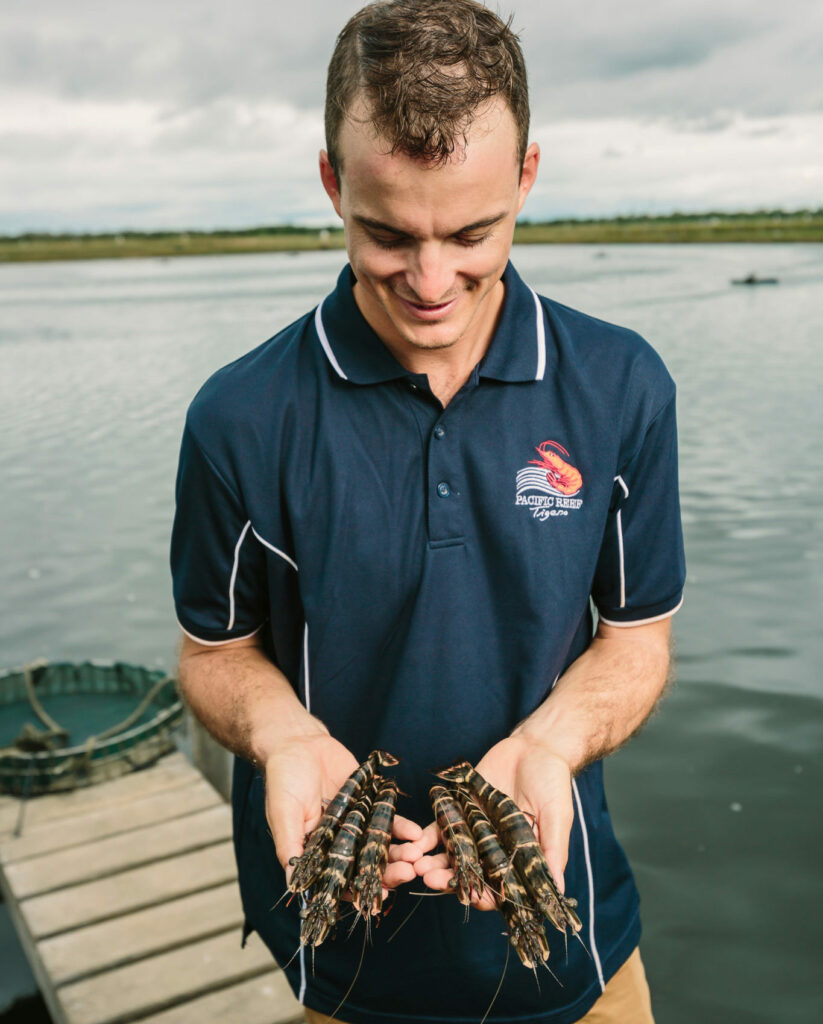
Sustainability Partners
SNP is grateful for the work conducted by organizations that support sustainable and responsible seafood with frameworks for those in the seafood sector to be able to bring healthy seafood to the consumer, including:
- Alaska Responsible Fisheries Management (RFM)
- Alaska Seafood Marketing Institute
- Aquaculture Stewardship Council
- Aquarium of the Pacific – Seafood for the Future
- Conservation Alliance for Seafood Solutions
- Environmental Defense Fund
- Fair Trade USA
- FishChoice
- FishWise
- Global Salmon Initiative
- Global Seafood Alliance/Best Aquaculture Practices
- Global Seafood Sustainability Initiative
- International Seafood Sustainability Foundation
- Marine Stewardship Council
- NFI Better Seafood Board
- National Aquarium
- NOAA Fisheries & Aquaculture, Sea Grant, and FishWatch.gov
- Sea Pact
- Sustainable Fisheries Partnership
- UN FAO Fisheries & Aquaculture
- World Economic Forum – Blue Food Partnership
- World Wildlife Fund

